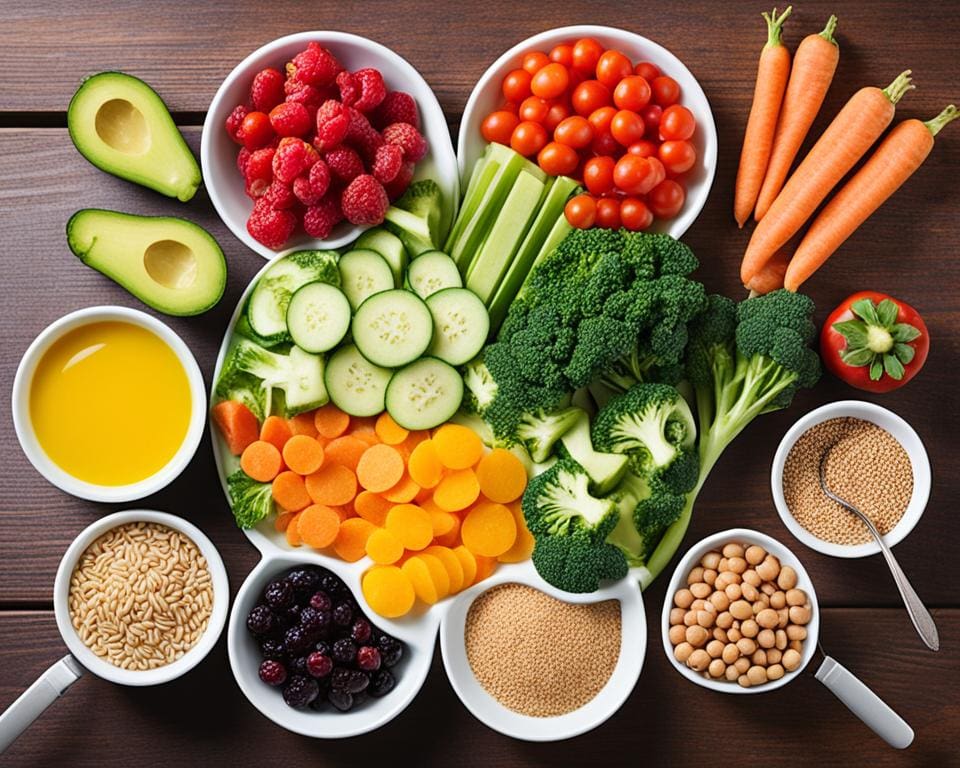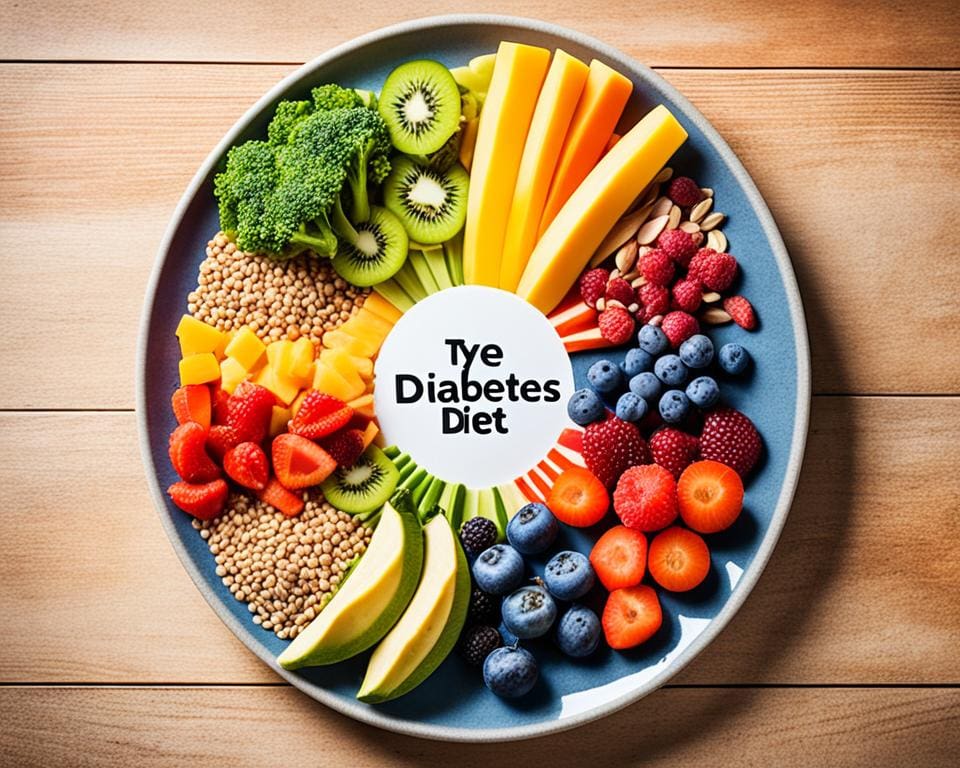Prepping meals can keep you ready with healthy options, especially for those managing diabetes. It takes a little planning but leads to simple, nutritious dishes. These meals can help control blood sugar and support diabetes care1. It’s all about choosing the right kinds of food like complex carbs, lean proteins, and healthy fats. This way, you can make meals that keep your blood sugar levels in check.
For diabetes meal prep, look for recipes that are simple and quick to make1. Include foods such as legumes, whole grains, and veggies. Also, add in low-fat dairy and lean proteins to have well-rounded meals. These meals will give you energy and can even help manage insulin resistance1. Dishes like sheet-pan chicken bowls or overnight oats are perfect for when you’re on the go1.
Add different flavors and styles to your meal prep to keep it interesting. You could try making Chickpea & Roasted Red Pepper Lettuce Wraps, Zucchini Mini Muffins, or White Chicken Chili. Mixing it up keeps your meals exciting1. Plus, many of these can be frozen, which saves time and cuts down on stress. With these ready-to-eat meals, you’re better set to control your diabetes and reach your health goals.
Key Takeaways
- Meal prepping simplifies healthy eating for diabetes management and blood sugar control.
- Focus on complex carbs, lean proteins, healthy fats, and fiber-rich ingredients.
- Choose recipes that require 3 steps or less for efficiency and convenience.
- Incorporate a variety of flavors and cuisines to keep meals exciting and satisfying.
- Prepare make-ahead and freezer-friendly options for grab-and-go ease.
Understanding Diabetes and Diet
Managing diabetes through what you eat is key in keeping your blood sugar in check and avoiding problems. Changing your diet a little can really help over time2. Losing just 5% of your weight can make a big difference in how well you control your blood sugar and other diabetes issues3.
To keep diabetes well-managed, lower how much sugar and simple carbs you eat. Try to eat more foods that are high in fiber. Adding lean meats, fruits, and veggies to your meals is also good for keeping your blood sugar steady and staying healthy2. The American Diabetes Association recommends that around 45% of your daily calories should come from carbohydrates for many people with diabetes3.
When you cook, choose methods that cut down on the fat and calories. You can use less fat than recipes suggest, like about 25% to 33% less4. You can also swap in applesauce or mashed bananas for part or all of the fat in baked goods to lower the fat4.
Picking the right fats is also crucial for your heart’s health. Healthy fats, such as those in almonds, olive oil, and fish, guard your heart against diseases4. Plus, choosing whole grains instead of refined ones boosts your meal’s nutrition4.
“The key to managing diabetes through diet is finding a balance that works for you and your lifestyle. By making informed choices and staying consistent, you can take control of your blood sugar levels and improve your overall health.” – Dr. Sarah Johnson, Registered Dietitian
For meal planning, think about using the plate method. This method divides your plate into sections for different types of food. It makes it easier to control how much you eat without measuring everything2. If you take insulin, keeping track of your carbs can help you decide how much insulin you need with each meal or snack2.
Remember, managing diabetes by what you eat is a journey. It takes time and effort. Stay educated, set reachable goals, and change your eating habits step by step. This way, you can get your blood sugar under control and boost your health and happiness.
Benefits of Meal Prepping for Diabetes Management
Meal prepping is great for anyone with diabetes. It helps you take charge of what you eat. You can make sure you’re getting nutritious meals. This way, you control the calories and portions, key for managing diabetes well5.

Saves Time and Reduces Stress
Meal prepping saves a lot of time during the week. Spent a bit of time on Sunday to plan and cook. Then, you have meals set for the whole week5. No more quick, bad food choices when you’re hungry. This can lower stress and keep your diet on track.
Helps with Portion Control and Calorie Management
Controlling your portions is crucial with diabetes. Eating too much can make the condition worse5. With meal prepping, you portion your food right. This means you get the correct amount of nutrients and calories. Taking care of portions and eating balanced meals can help keep your blood sugar in check and assist in weight management5.
For people with diabetes, the American Diabetes Association suggests eating less carbs, sugar, and fats5. Following these tips in your meal prep helps you stay at a healthy weight. It also keeps your blood sugar levels steady.
Ensures Balanced, Nutritious Meals
Meal prepping lets you add a variety of healthy foods to your diet. You should focus on good carbs like fruits, veggies, and whole grains. These are vital for a diet that helps manage diabetes. High-fiber foods, such as veggies, fruits, nuts, and whole grains, are key for diabetes control. They slow sugar intake and lower blood sugar spikes67.
When it comes to eating, focus on three main nutrients: carbs, proteins, and fats7. Include things like lean meats, fish, and tofu in your meals. These are great protein sources. Healthy fats, like avocados and nuts, can better your cholesterol levels6.
| Macronutrient | Sources | Benefits |
|---|---|---|
| Complex Carbohydrates | Fruits, vegetables, whole grains, legumes | Slow sugar absorption, prevent blood sugar spikes |
| Lean Proteins | Lean meats, poultry, fish, tofu, legumes | Maintain and repair body tissues, support weight management |
| Healthy Fats | Monounsaturated and polyunsaturated fats | Improve cholesterol levels, support heart health |
By including these key nutrients in your meal prep, you’re doing your body a big favor. You make sure you’re eating right for diabetes management. Meal prepping is a powerful part of a diabetes diet plan. It helps keep your blood sugar in check while promoting good health5.
Essentials of a Diabetic-Friendly Diet
A solid diet is key to keeping diabetes in check. It’s all about the right nutrients and smart food choices. To keep your blood sugar in line and stay healthy, focus on certain foods. Make complex carbs, lean proteins, good fats, and foods high in fiber your best friends.

Focus on Complex Carbohydrates
Toss complex carbs into your meals for steady blood sugar. Foods like beans, berries, and brown rice are great. They give you energy that lasts because they release slowly8. Adding these to your diet helps keep diabetes under control.
Include Lean Proteins
Lean proteins are crucial in managing diabetes. Think chicken, eggs, and fish — they keep you feeling full. Having 1 or 2 servings daily is a good goal9. Don’t forget plant proteins too. Foods like beans and lentils are loaded with fiber and good for you. Try to eat them a few times a day9.
Incorporate Healthy Fats
Don’t skip the healthy fats for your heart and blood sugar. Add avocado, nuts, and olive oil to your meals for their health benefits8. Eating fatty fish twice a week helps your heart more. It’s all about balance.
Prioritize Fiber-Rich Foods
Eating fiber helps slow digestion. This stops blood sugar spikes. Go for veggies that are low in calories and carbs. They include broccoli and salad greens. Try to fill half your plate with these veggies at every meal8. Also, eat fruits in small amounts, like a fist-sized portion. This keeps your sugar steady9.
Over 38.4 million people in the United States were estimated to have diabetes as of 2023, with the majority having type 2 diabetes. Weight loss and exercise have demonstrated the potential to prevent and treat type 2 diabetes, with some cases even achieving remission9.
Stick to a diet rich in complex carbs, lean proteins, good fats, and fiber. This mix helps you manage blood sugar and stay well. Don’t hesitate to get advice from a diet pro or a diabetes clinic. They can tailor a plan just for you8.
Meal Prep Tips for Diabetic-Friendly Meals
Preparation is vital when planning meals to manage diabetes. Spending time to cook meals ahead and divide them into portions is smart. It means you always have a healthy choice ready, saving time and stress. Plus, it aids in managing portion sizes and calories10.

Start by choosing recipes that include good carbohydrates, proteins, and fibers. Foods like brown rice, oatmeal, and quinoa help keep your blood sugar levels steady. Pair them with lean meats, fish, beans, and Greek yogurt for needed proteins1011. Remember to add plenty of non-starchy vegetables for their low-calorie, high fiber, vitamin, and mineral benefits.
According to the CDC, losing 5%-10% of body weight can improve blood sugar control11.
Here are some pointers for meal prep:
- Choose top-notch storage containers to keep your meals fresh and neat.
- Enhance flavors with herbs, spices, and sauces that are low in sugar and salt.
- Divide your meals into portions to keep control of what you eat and for easy snacking.
- Use both the fridge and freezer to store meals, which extends their life.
Remember, meal prepping is excellent for managing diabetes, but it’s just one part. Regular exercise, like a mix of cardio and strength training, can also lower blood sugar11. Even a quick 10-minute walk after eating might be better for lowering blood sugar than a 30-minute daily walk10.
| Meal Prep Component | Tips |
|---|---|
| Proteins | Batch cook lean meats, fish, and plant-based proteins for easy meal assembly. |
| Carbohydrates | Prepare complex carbs like brown rice, quinoa, and sweet potatoes in advance. |
| Vegetables | Wash, chop, and store a variety of non-starchy vegetables for quick access. |
| Snacks | Pre-portion healthy snacks like nuts, seeds, and fresh fruit for on-the-go fuel. |
By mixing these meal prep practices with nutritious, diabetes-friendly foods, you’re on your way to improved blood sugar and health. Keep in mind, being consistent is crucial. Start with small steps and increase as you get more used to prepping.
Breakfast Meal Prep Ideas
It’s smart to start your day with a healthy breakfast when you’re managing diabetes. Doing so means preparing your meals ahead of time. You’ll have a low-sugar and protein-rich breakfast waiting, even if you’re in a rush. Here are some simple and tasty breakfast meal prep ideas that fit well with a diabetes-friendly plan.

Overnight Oats with Berries and Nuts
Overnight oats are easy to make and healthy. You just mix rolled oats, low-fat milk or yogurt, and your favorite low-sugar fruits and nuts in a jar12. This dish is both filling and nutritious for breakfast12. You can include chia seeds for more omega-3 fatty acids13. Leave it in the fridge overnight. By the morning, you got yourself a tasty, fiber-rich meal12.
Egg Muffins with Spinach and Feta
Egg muffins are a great protein-rich breakfast. You can add your favorite veggies and cheese. Just mix eggs, spinach, feta cheese, and other favorite ingredients, and bake in a muffin tin12. Make a batch ahead of time for a fast, filling breakfast to go. They are perfect for those managing diabetes because of their high protein content13.
Chia Seed Pudding with Low-Fat Greek Yogurt
Chia seed pudding is tasty and full of nutrients. Combine the chia seeds with low-fat milk or Greek yogurt and let them sit in the fridge overnight12. By morning, it turns into a pudding. Top with berries or sugar-free syrup. Using Greek yogurt adds more protein to this healthy breakfast12.
| Breakfast Meal Prep Idea | Key Ingredients | Benefits |
|---|---|---|
| Overnight Oats with Berries and Nuts | Rolled oats, low-fat milk or yogurt, low-sugar fruits, nuts, chia seeds | Convenient, customizable, fiber-rich, healthy omega-3 fatty acids |
| Egg Muffins with Spinach and Feta | Eggs, spinach, feta cheese | Protein-rich, customizable, portable, easy to reheat |
| Chia Seed Pudding with Low-Fat Greek Yogurt | Chia seeds, low-fat milk or Greek yogurt, fresh berries or sugar-free syrup | High in fiber and protein, creamy texture, low-sugar |
Adding these healthy breakfast ideas to your meal planning is a great step in managing diabetes. A balanced, nutritious breakfast plays a huge role in keeping your blood sugar levels steady all day long.
Lunch Meal Prep Ideas
Planning lunches ahead can be a big help for those with diabetes. It means you always have a healthy meal ready, no matter how busy you are. We’ll share tasty and good-for-diabetes lunch prep ideas below:

Mason Jar Salads with Grilled Chicken and Quinoa
Mason jar salads are easy to make and look great. Simply put the dressing at the bottom, followed by layers of grilled chicken, quinoa, and veggies. These lunches are diabetic-friendly, with under 500 calories and 45 carbs, and over 25 grams of protein14.
They mix lean meats, healthy fats, and high-fiber foods, good for controlling blood sugar14.
Vegetable and Hummus Wrap
A wrap with hummus and veggies is a great choice for a low-carb plant-based lunch. Start with a whole-wheat tortilla spread with hummus. Add lettuce, tomato, cucumber, and roasted peppers. This lunch helps in managing blood sugar levels because of the wrap and veggies1. Hummus, from chickpeas, is full of protein and healthy fats, which keeps you full1.
Tuna Salad Lettuce Cups
Tuna salad in lettuce cups is a healthy, low-carb option. Mix tuna, celery, red onion, and a little mayo or Greek yogurt. Put it in lettuce leaves, and enjoy a light meal. The ADA suggests eating around 3 ounces of lean protein per meal15. Tuna gives you that protein plus omega-3s, which ADA says you should eat twice a week15.
With a little planning and preparation, you can create delicious and nutritious lunches that support your diabetes management goals.
When prepping for diabetes, aim for meals balanced in carbs, proteins, fats, and fibers. Prepare these healthy lunch ideas ahead of time. This way, you can easily stay on track with a healthy eating plan, even when busy.
Dinner Meal Prep Ideas
Looking for healthy dinner ideas that are diabetes-friendly? Meal prepping is key. Prep your meals ahead of time and always have a balanced dinner ready, even during hectic nights. We’ve got some tasty and good-for-you dinner meal prep suggestions for those with diabetes.
Sheet Pan Chicken and Roasted Vegetables
Sheet pan dinners are perfect for easy dinner prep. Put chicken breasts and veggies on a sheet, add herbs, and cook. It’s a breeze to make a full meal with little work, ensuring you get protein from chicken and vitamins from veggies16. Doctors often suggest chicken for those with diabetes, making this a top meal idea16.
Slow Cooker Turkey Chili with Sweet Potatoes
Using a slow cooker is also a smart choice for easy dinner prep. Try turkey chili with sweet potatoes. It’s a warm, healthy meal that’s simple to make ahead. Turkey gives you protein, and sweet potatoes have good carbs and fiber17. Nearly three quarters of diabetic recipes use turkey, highlighting its health benefits17. This chili is easy to prepare in big batches, ensuring you have several nutritious and balanced dinners for the week.
Baked Salmon with Asparagus and Brown Rice
Baking salmon, asparagus, and brown rice makes for a good-for-the-heart meal in no time. Salmon is especially recommended for diabetes, packed with beneficial fats and protein17. Nine out of 58 diabetic recipes actually include salmon, affirming its status as a superfood17. Asparagus and brown rice complement this dish well. Asparagus is a low-carb veggie rich in fiber, and brown rice adds healthy carbs18. Follow the Diabetes Plate Method and this meal fits perfectly: half veggies, a quarter protein, and a quarter carbohydrates18.
By making these healthy dinner ideas part of your prep routine, you simplify creating diabetes-friendly meals. A little prep lets you enjoy tasty, nutritious dinners that support your health and diabetes management.
Snack Meal Prep Ideas
Snacks are crucial for managing diabetes and keeping blood sugar steady. Having a variety of healthy snacks is key. Meal prepping ensures you always have good choices on hand. This way, you stay away from unhealthy foods when you’re hungry. Focus on snacks high in protein and fiber to keep you energetic all day.
Hard-Boiled Eggs
Hard-boiled eggs are a top choice for a quick, protein-packed snack. They’re easy to prepare ahead of time and keep in the fridge. A pair of hard-boiled eggs with almonds and carrots is a filling, healthy option19. According to the 7-day diabetes meal plan, snacks should be around 15 grams of carbs and 100-150 calories. This makes hard-boiled eggs an ideal choice20.
Veggie Sticks with Guacamole
Cut veggies with guacamole are a good, low-carb snack. This mix helps limit carb intake and control blood sugar. The good fats from avocados and the fiber in veggies keep you full21. Making your guacamole lets you watch the salt and pick your favorite tastes, which is better than buying it from the store21.
Apple Slices with Almond Butter
Apple slices and almond butter are a great combo for balanced energy. Apples’ fiber slows sugar uptake. The healthy fats and protein in almond butter keep you satisfied between meals. This snack is both tasty and a solid choice for managing your sugar levels.
Healthy snacks are handy and can be enjoyed a lot. With these snack prep ideas, you can make good choices easily. This helps you with diabetes and keeps your energy steady all day.
Choosing the right snacks is important for diabetes. Go for protein-rich, low-sugar, and fiber-packed snacks. They’ll help keep your health on track.
Diabetic Friendly Meals for Special Occasions
Special occasions can be tricky for those with diabetes during meal planning. However, with careful preparation and focus on healthier choices, you can make tasty meals. These meals will please everyone and fit into a diabetic-friendly diet.
Start by choosing lean proteins like chicken, turkey, and seafood for your menu. About 60% of easy weeknight dinner recipes for diabetes focus on seafood, like salmon22. You might enjoy Mediterranean chicken souvlaki with a yogurt salad. It’s flavorful and healthy. Grilled salmon kabobs are also a great option, showing their helpful nutrients in one serving23.
Add non-starchy vegetables and whole grains for well-balanced meals. A Mediterranean broccoli salad is healthy and tasty. It brings in good nutrition with every serving23. Quinoa pizza, with vegetables on top, is delicious too. It offers balance in calories and nutrients in a single serving23.
For dessert, aim for low-sugar items that are still delightful. Many diabetes-friendly dessert recipes include items made from chocolate, like mousse and truffles22. You can also go for fresh fruit salads or small, low-sugar desserts in limited amounts.
“The key to managing diabetes well during special events is to plan and choose wisely. Practice portion control, and get creative. With these steps, you can make meals both delicious and healthy for everyone.”
To help with watching what you eat, try these ideas:
- Use smaller plates to help control portion sizes
- Provide a variety of healthy options to satisfy different tastes and preferences
- Encourage guests to savor each bite and eat slowly
- Offer water or unsweetened beverages to help manage blood sugar levels
These tips, along with choosing the right ingredients, can lead to great meals. They’re perfect for celebrating any special occasion, while keeping healthy habits in check.
Meal Prepping for One vs. Family
Whether you meal prep just for yourself or for your whole family, the basics are similar for both. Yet, there are important differences when planning for one or many.
For your own meals, choose recipes that can downscale easily and keep well in single portions. Weeknight dinners finish in about 30 minutes24, perfect for people with busy schedules. Don’t shy away from batch cooking and freezing extra portions. This way, you can enjoy a variety of meals and keep your kitchen and time in check.
When prepping meals for a group, focus on making bigger batches and meals that can adjust to everyone’s liking. Expect to cook meals that are between 144 and 618 calories, with a protein content of 9 to 38 grams, carbs from 18 to 56 grams, and fats from 3 to 29 grams per serving25. It’s key to involve your family in the planning stages to make sure you’re meeting their dietary needs and personal tastes.
No matter the household size, aim for meals packed with nutrients that also fit a diabetic diet. On average, expect to serve meals with 33 to 56 grams of carbs, which is around 2 to 3.5 carb servings per serving24. Use complex carbs, lean proteins, healthy fats, and fiber to keep blood sugar steady and boost your health.
A hearty mix of black beans and quinoa is recommended for those with diabetes26.
Here are some handy tips to make meal prepping simpler:
- Invest in quality storage containers to keep your meals fresh and organized
- Dedicate time each week to planning, grocery shopping, and batch cooking
- Incorporate a variety of flavors and textures to prevent taste fatigue
- Don’t be afraid to experiment with new recipes and ingredients
Adapting your meal prep to fit your family size and following diabetic dietary guidelines is the recipe for success. Cooking for one or many, consistency and creativity are key. Enjoy the path towards healthier eating and living.
Storing and Reheating Prepped Meals
Meal prepping is key for managing diabetes. It’s important to store and reheat food right. This keeps the meals tasty and safe to eat. Also, it helps keep the nutrients locked in.
Proper Storage Containers
Choose the best containers to keep your meals fresh and safe. Go for containers that keep air out and are okay to use in the microwave27. Glass or BPA-free plastic with snug lids are great. They stop food from going bad and make storing and reheating meals simple.
For big meals like Spaghetti with Quick Meat Sauce, using the right containers is a must for saving leftovers28. For lunch portions, air-tight containers work perfectly with the diabetes-friendly recipes, each recipe making four meals29.
Safe Refrigeration and Freezing
Most meals can be kept in the fridge for up to four days27. Remember, put them in the fridge within two hours of cooking to dodge bacteria27. For meals not eaten in four days, freezing is a good idea for later use.
When prepping for a week, make meals four days ahead for the best taste and safety29. This works well with recipes making four lunches29.
Reheating Techniques
Reheating meals right is vital for safe and tasty food. Make sure meals get to 165°F (74°C) when heating27. Use a thermometer to check the temperature.
Reheat in the microwave, oven, or on the stovetop, as you like. To keep meals moist, use a bit of water or broth. This is good for recipes like Chicken & Mushroom Shepherd’s Pie or Spaghetti with Quick Meat Sauce from our diabetes-friendly collection28.
| Storage Method | Temperature | Duration |
|---|---|---|
| Refrigeration | 40°F (4°C) or below | Up to 4 days |
| Freezing | 0°F (-18°C) or below | Up to 3 months |
| Reheating | 165°F (74°C) or above | Until heated through |
By following these steps, you can make sure your diabetes-friendly meals are safe, healthy, and tasty. Doing this will make it easier to stick to your meal plan and manage your diabetes well.
Staying Motivated and Consistent with Meal Prepping
Maintaining motivation and consistency is crucial for successful meal prep and healthy eating. It’s vital to set goals that fit into your daily life30. Begin by prepping just one meal in advance, then work up to preparing all meals. This method helps you stay consistent without getting too stressed.
To keep motivation up, try planning your menu for the week ahead of time. This makes shopping and cooking easier and saves you time and money31. Include a mix of food groups in your menu. Aim for more whole foods and less of things like refined grains and sugars, and too much salt31. Mia Syn, MS, RDN, advises spending an hour or two each week to make your meal plan and shopping list30. Try new proteins, like tofu and quinoa, to keep your meals exciting30.
Sharing the meal prep with family and friends can turn it into a fun, social event. Let them know your meal prepping goals and ask for their help. When you achieve your goals, celebrate together. And if you slip up, that’s okay. The most important thing is to keep trying. With reachable goals, weekly planning, and support from others, you’ll stay motivated to prepare nutritious meals.
FAQ
How can meal prepping help with diabetes management?
Meal prepping saves time and cuts stress. It helps with portion and calorie control. This makes sure you eat balanced, nutritious meals.
Healthy meals are ready to go. This helps keep your blood sugar stable all day.
What are the key components of a diabetic-friendly diet?
A diabetic-friendly diet should center on certain types of food. These include complex carbs, lean proteins, and healthy fats. Plus, fiber-rich foods play a big role.
Complex carbs give slow energy. Lean proteins keep you full. Healthy fats help your heart and control sugar. Fiber slows digestion and keeps blood sugar even.
What are some easy breakfast meal prep ideas for diabetes management?
Try overnight oats with berries and nuts. Or, make egg muffins with spinach and feta. Chia seed pudding with low-fat yogurt is another good choice.
These breakfasts are high in fiber, protein, and good fats. They help keep your blood sugar stable.
How can I meal prep healthy lunches for managing diabetes?
For lunch, consider mason jar salads with chicken and quinoa. Hummus and vegetable wraps are also a great option. Tuna salad in lettuce cups is quick and healthy.
These meals offer a mix of nutrients and are easy to make early.
What are some quick and healthy dinner meal prep ideas for diabetes?
For dinner, try sheet pan chicken and veggies. Slow cooker turkey chili with sweet potatoes is another winner. Or, bake salmon, asparagus, and brown rice.
These dishes are simple, rich in nutrients, and keep your blood sugar steady.
How long can I safely store prepped meals in the refrigerator?
Prepped meals can stay fresh in the fridge for up to four days. Just keep them airtight. You can also freeze them for later.
When heating, make sure your meals hit 165°F (74°C). This avoids getting sick.
How can I stay motivated and consistent with meal prepping?
To keep at it, set goals that fit your life. Start small and work up. Plan your meals ahead and get your family involved.
Celebrate your progress. It’s important to stay positive.
Source Links
- https://www.eatingwell.com/gallery/8032624/simple-diabetes-friendly-meal-prep-ideas/
- https://www.niddk.nih.gov/health-information/diabetes/overview/healthy-living-with-diabetes
- https://www.healthline.com/health/diabetes/diabetic-friendly-diets-to-lose-weight
- https://www.webmd.com/diabetes/diabetes-recipes-cooking-tips-diabetic-friendly-meal
- https://klinio.com/blog/benefits-of-diabetic-meal-prep/
- https://www.mayoclinic.org/diseases-conditions/diabetes/in-depth/diabetes-diet/art-20044295
- https://pureplatesstl.com/blogs/pure-plate-blog/navigating-diabetic-meal-planning-a-comprehensive-guide
- https://health.clevelandclinic.org/diabetic-diet
- https://www.healthline.com/health/diabetes/diabetic-friendly-grocery-list
- https://fitmencook.com/blog/diabetes-meal-prep-for-beginners/
- https://www.eatingwell.com/article/7886108/diabetes-meal-plan-for-beginners/
- https://www.eatingwell.com/gallery/8038023/30-day-breakfast-plan-for-diabetes/
- https://www.eatingwell.com/make-ahead-diabetes-friendly-breakfast-recipes-8572511
- https://www.tasteofhome.com/collection/diabetic-lunch-recipes/
- https://www.verywellhealth.com/lunch-choices-you-must-try-1087499
- https://www.healthline.com/health/nutrition/diabetes-recipes-dinner
- https://www.tasteofhome.com/collection/delicious-diabetic-friendly-dinner-recipes/
- https://www.foodnetwork.com/healthyeats/diets/diabetes-meal-prep
- https://www.everydayhealth.com/type-2-diabetes/diet/seven-lunch-ideas-for-diabetes/
- https://www.diabetes.ca/nutrition—fitness/meal-planning/7-day-diabetes-meal-plan
- https://www.healthline.com/health/type-2-diabetes/seven-day-meal-plan
- https://www.epicurious.com/collection/type-2-diabetes-recipes
- https://www.everydayhealth.com/type-2-diabetes/diet/delicious-diabetes-friendly-dinner-ideas/
- https://www.eatingwell.com/article/7993114/diabetes-family-friendly-dinner-plan/
- https://www.verywellfit.com/7-day-diabetic-meal-plan-ideas-recipes-and-prep-6501837
- https://www.allrecipes.com/gallery/diabetes-friendly-family-dinners/
- https://discover.texasrealfood.com/meal-prep-mania/how-to-meal-prep-for-a-diabetes-friendly-diet
- https://www.eatingwell.com/gallery/8017621/diabetes-friendly-dinners-to-make-ahead/
- https://www.eatingwell.com/article/2057841/how-to-meal-prep-a-week-of-diabetes-friendly-lunches-for-work/
- https://www.everydayhealth.com/diet-nutrition/meal-prep-tips-every-beginner-should-know/
- https://www.healthline.com/nutrition/meal-prep-tips

















































